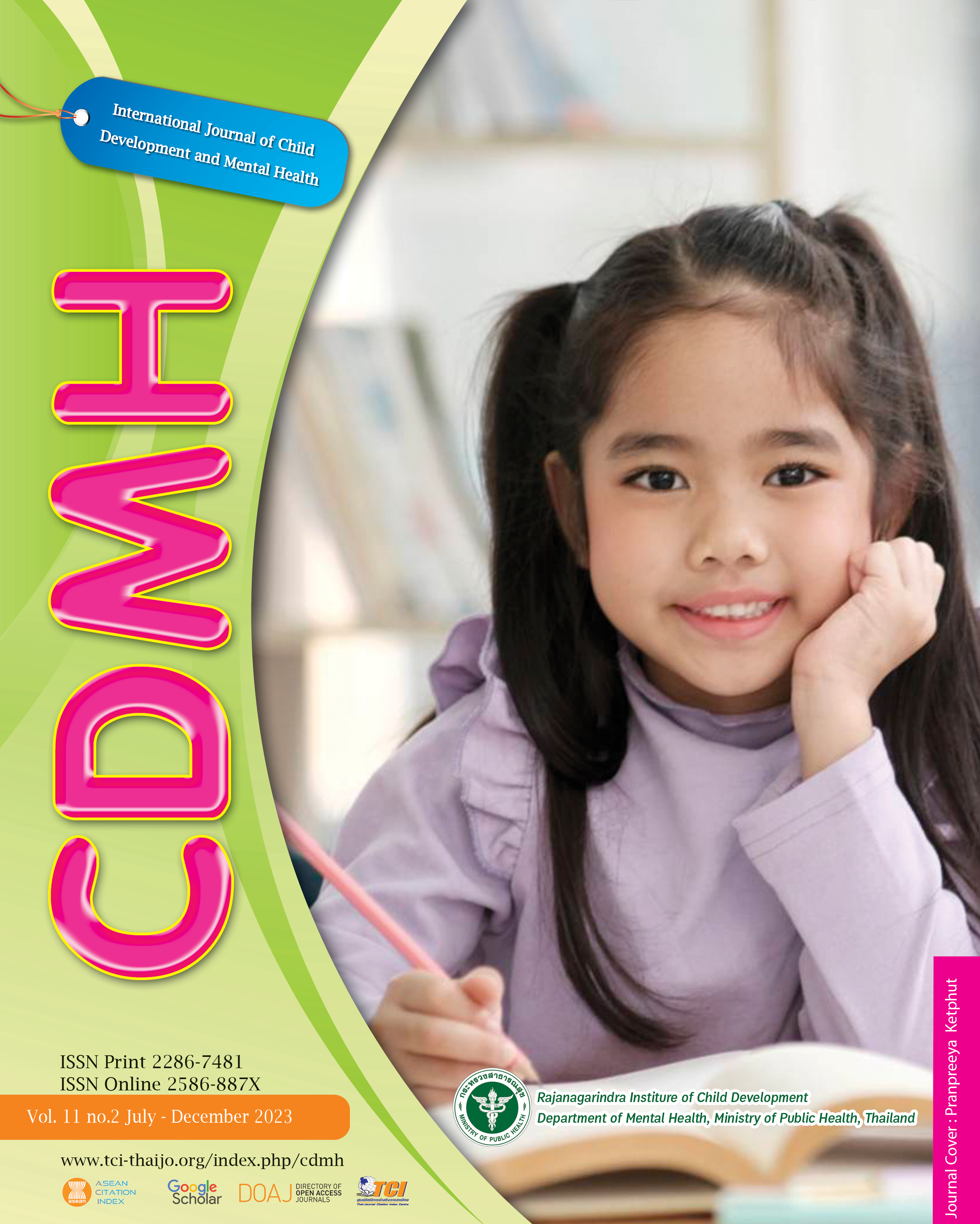A model of developmental stimulation by applying the concept of Snoezelen for parents and caregivers of preschool autistic children Program for parents and caregivers
Main Article Content
Abstract
This study is aimed to develop and to evaluate the validity of the
developmental stimulation program by applying the multisensory
approach for parents and caregivers of preschool autistic children. This study
consisted of two phases. The first phase explored perspectives for design program and analyzed the content validity by examining the index of
item objective congruence (IOC). The second phase was a focus group
discussion with eight caregivers of preschool autistic children regarding
the opinions after implementation. The developmental stimulation program
was developed basing on the therapeutic use-of-self approach, daily
living activities, play environment and development stimulation, related
knowledge and strategies in family’s context, and sharing between
families. The program components consisted of three activities for
caregivers such as meeting and understanding the nature of individual child, learning of child’s surroundings, and designing of an individual new
lifestyle. Validity of the program was acceptable (IOC = 0.6-1.0). After
implementing the program in eight families, the result showed four crucial points. First, caregivers were able to understand the natural behavior of
the children. Second, the caregivers could improve their child
development. Third, there were strengths and limitations of the pilot
program. Finally, the way of improving program effectiveness was found
out. A model of developmental stimulation by applying the concept of
Snoezelen technique for caregivers of preschool autistic children can
increase understanding of natural individual child by caregivers. This
understanding led to child development progression, adjust surroundings or occupational performances with autistic children, and encourage the
empowerment of caregiver needs by supporting system and continuity of services. Further study might consider the cost-effectiveness and efficiency
of the program for parents and caregivers of preschool autistic children
before implementing in the real situation.
Article Details

This work is licensed under a Creative Commons Attribution-NonCommercial-NoDerivatives 4.0 International License.
![]()
Creative Commons License
This work is licensed under a Creative Commons Attribution-NonCommercial-No Derivatives 4.0 International (CC BY-NC-ND 4.0)
The authors retain copyright and permit the journal the copyright of first publication
Articles, once having passed the review process and accepted for publication in the CDMH Journal, are copyrighted under the CDMH Journal, Department of Mental Health, Ministry of Public Health. Please be aware distribution of CDMH Journal content for commercial purposes without permission is expressly prohibited. However, distribution with intent to educate, advocate, or spread awareness within the general public and research communities is permitted and encouraged with the understanding that the CDMH Journal Editorial Board do not hold jurisdiction or liability for any accompanying comments, text, or information from third parties, either in favor for or against the original article’s assertions, conclusions, methodology, or content.
References
Apiwatanakul, P., Boonrod, A., Kittipanya-ngam,
P., Sermsak Sumanont, S., Suvarnnato, T., (2020).
The Validity of Pre- and Post-Anterior Cruciate
Ligament Reconstruction Surgery Manual of
Srinagarind Hospital. Srinagarind Med J 2020;
(5) 531-536 (InThai)
Ong-atsakunman, R., Mueansunthorn, S., Chammak,
C., (2015). Survey of the prevalence of autism among children aged 1-4 years in Thailand. Retrieved 2nd
August 2023, from https://ycap.go.th/research/318/ (In Thai)
Siphetcharawut, S., (2008). Participation in Occupation. Teaching materials for lifestyle activities courses (513251), (Document not published), Department
of Occupational Therapy, Faculty of Medical
Technology, Chiang Mai University (copy) (In Thai)
Duvall, E. M. (1971). Family Development fourth edition. Philadephia: J.B.Lippincott Company.
Khwunkeeree, N., (1998). A study of parents’ roles on
providing early intervention for autistic young
children in Bangkok metropolis. Master of Education
Thesis, Elementary Education field, Faculty of
Education, Chula University.(In Thai)
Jaffe, L., Humphry, R., & Case-Smith, J. (2010). Working with families. In Case-Smith, J., & Clifford O’ Brien, J. (Eds.), Occupational Therapy for Children 6 Edition. St. Louis: Mosby.
Kielhofner, G. (2004). Conceptual foundations of
occupational therapy, 3 edition. Philadelphia: Davis Company.
Koontz-Lowman, D. (2005). Family and disability issues through infancy. In Cronin, A., & Mandich, M. (Eds.). Human Development and Performance throughout Lifespan. Clifton Park, NY: Thomson corporation.
Primeau, L. A. (1995). Orchestration of work and play
within families. University of Southern California.
Unwin, K. L., Powell, G., & Jones, C. R. (2021). A
sequential mixed-methods approach to exploring the experiences of practitioners who have worked in
multi-sensory environments with autistic children.
Research in Developmental Disabilities, 118, 104061.
Werner, P. (2004) Reasoned Action and Planned Behavior. In: Peterson, S.J. and Bredow, T., Eds., Middle Range Theories: Application to Nursing Research, Lippincott Williams & Wilkins, Philadelphia, 125-147.
Wilcock, A. (1998). An occupational perspective on health. Thorofare, NJ: SLACK Incorporated.
Wood, P. (1996). Legitimatizing occupational therapy knowledge. American Journal of Occupational
Therapy, 50(8), 626-634.


